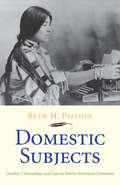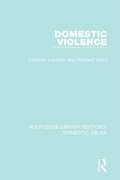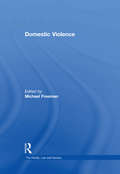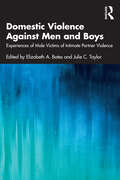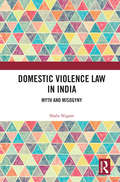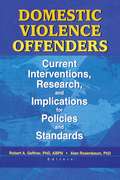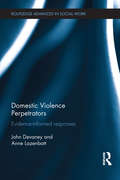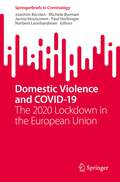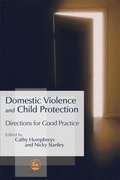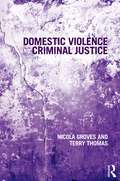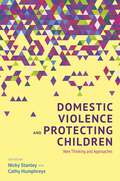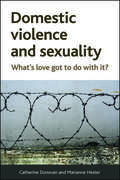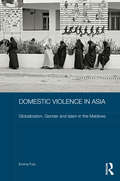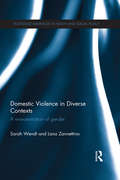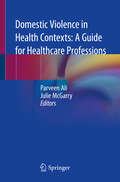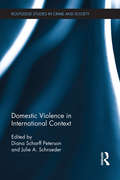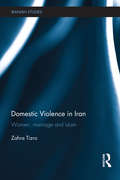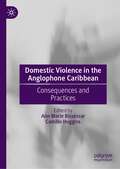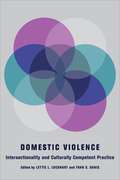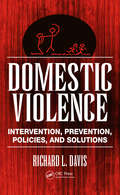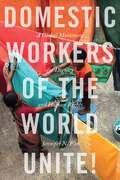- Table View
- List View
Domestic Servants in Literature and Testimony in Brazil, 1889–1999
by Sônia RoncadorDrawing from a variety of historical sources, theory, and fictional and non-fictional production, this book addresses the cultural imaginary of domestic servants in modern Brazil and demonstrates maids' symbolic centrality to shifting notions of servitude, subordination, femininity, and domesticity.
Domestic Subjects
by Beth H. PiatoteAmid the decline of U.S. military campaigns against Native Americans in the late nineteenth century, assimilation policy arose as the new front in the Indian Wars, with its weapons the deployment of culture and law, and its locus the American Indian home and family. In this groundbreaking interdisciplinary work, Piatote tracks the double movement of literature and law in the contest over the aims of settler-national domestication and the defense of tribal-national culture, political rights, and territory.
Domestic Violence (Routledge Library Editions: Domestic Abuse #5)
by Deborah Lockton Richard WardFirst published in 1997, this book marks a culmination of a three year research programme focused upon the incidence of domestic violence in Leicester. The study examined the levels of violence, the details of applicants and respondents and the nature of complaints, as well as the policies applied and the problems faced by those enforcing the law. The books sets the findings in the context of the policies on protection of victims of domestic violence, the problems they face and protection after 1997. This book will be of interest to those studying law, social work, sociology and women’s studies.
Domestic Violence (The Family, Law and Society)
by Michael FreemanDomestic violence - domestic hooliganism it has been called - is one of the cancers of our age. This volume offers a challenging selection of materials as a picture of a multi-faceted problem. The issues embraced range from criminal and civil law responses and the value of mediation, to the impact on children, and to the cultural context. The materials are derived from a variety of sources and from different disciplines to offer the reader an understanding of the problem not easily culled from standard library resources.
Domestic Violence Against Men and Boys: Experiences of Male Victims of Intimate Partner Violence
by Elizabeth A. Bates Julie C. TaylorDomestic Violence Against Men and Boys: Experiences of Male Victims of Intimate Partner Violence is a unique book that brings together contemporary research and practice around working with men and boys who are victims of domestic violence and abuse. The book features contributions from experts within the field who draw on the wide range of evidence that demonstrates the multifarious experiences and impacts of this victimisation. This text focusses on the increasing evidence related to the prevalence of domestic violence and abuse within the family towards men and boys. With contributions from experts within the field, this book covers a comprehensive list of topics derived from empirical evidence. The chapters focus on key themes, such as, experience of the abuse; challenges to the current theory; barriers and experiences of help-seeking; impact on children, and working with male victims within practice and criminal justice settings. Further, the text underscores numerous recommendations around changing current practices to enable a better support system for men and boys. The text will therefore be invaluable in increasing awareness of the research and support in the field of domestic violence. This book will be of use to researchers, practitioners and educators working in the field of domestic violence and abuse. It will also be beneficial to policy makers who are reviewing legislation and those involved in commissioning psychological services, and victim services that work with male victims.
Domestic Violence Law in India: Myth and Misogyny
by Shalu NigamThis book examines the prevailing legal discourse surrounding domestic violence law in India. It investigates the myths, patriarchal stereotypes, and misconceptions that undermine the process of justice and dilute legal provisions to the detriment of survivors. The volume: Develops arguments based on legal case studies and draws extensively on knowledge from various fields of study, as well as the experience of women survivors. Examines fallacies within the legal framework through a study of strategic lawsuits against public participation suits within the Indian context. Proposes measures for a fair and more gender inclusive legal system that focuses on facilitating access to justice. Suggests that emphasis be laid on establishing the rule of law and eliminating the culture of violence. A key text on gender and law in India, this book will be indispensable to scholars and researchers of socio-legal studies, law, gender, human rights, women’s studies, social science, political science, and feminist jurisprudence in South Asia. It will also be of interest to NGOs, activists, and lawyers.
Domestic Violence Offenders: Current Interventions, Research, and Implications for Policies and Standards
by Alan RosenbaumWomen’s shelters and safe houses were a good first step, but they only address part of the problem. Learn what else must be done to address the problem of domestic violence! Domestic Violence Offenders presents recent research, current interventions, and legal standards for people arrested for domestic violence. It also addresses the controversies that have arisen in the wake of the mandatory standards for batterer interventions that have been established by various jurisdictions, examining the type of treatment modality and content permitted by various jurisdictions, the duration of treatment, and the relationship of the various standards to actual research. This essential book also provides suggestions for a more inclusive, less rigid process for creating standards and policies for use with this population. Handy tables and charts make the information easily accessible. From the editors: “The initial societal response to intimate partner violence was the development of the shelter movement for battered women. Women&’s shelters and/or safe houses developed in almost all major population areas throughout the United States and abroad. The goals were to provide a safe environment for abused women and their children, to offer advocacy, counseling, and medical services, and to empower women to leave their abusers. While shelters continue to serve these and other critical needs and are an essential part of the service delivery system for battered women, they address only part of the problem. Left untreated, batterers often will continue to abuse their partners who leave shelters and return to the relationship. If their partners leave the relationship, the batterers may find new victims to abuse. The response to this harsh reality was the development of batterer intervention programs.” Domestic Violence Offenders provides you with informed discussions of: the implications of research and policies for those providing interventions why it is premature for states to establish certain rigid standards for batterer programs, and how some of the current standards may produce more harm than good the history of batterer intervention programs completion and recidivism among court- and self-referred batterers the Alternatives to Violence program and the experiences and perceptions of its founder common aspects of various intervention programs—confidentiality, group structure and length, partner contacts, leadership configuration, and program goals topics addressed by most programs—power and control, anger management, substance abuse, stress reduction, parenting, communication, and more the controversial and often misunderstood issue of female partner aggression and violence the Stages of Change approach to domestic violence treatment lethality assessment and safety planning for partners of batterers the advantages of conjoint therapy for certain types of cases the Illinois Protocol for batterer programs outcome research on programs for batterers and a great deal more!
Domestic Violence Perpetrators: Evidence-Informed Responses (Routledge Advances in Social Work)
by Anne Lazenbatt John DevaneyDomestic violence is a serious, widespread public, social and health problem that affects the lives of many women, children and men. There is also evidence to suggest it has one of the highest rates of recidivism. This comprehensive book provides an overview of what the research tells us about the perpetrators of domestic violence and what works, and what doesn’t, in promoting positive change. Collecting together the most up-to-date evidence from the international literature and bringing psychological, sociological, gendered and socio-political theoretical perspectives to bear on the issue, the authors explore: - what domestic violence is, why it happens and how it can be measured - who the perpetrators of domestic violence are, including discussion of non-stereotypical patterns such as male victims, female perpetrators, couples where the abuse is mutual, and couples with abusive relationships who want the abuse to end but the relationship to be sustained - strategies for engaging perpetrators in interventions and for promoting behaviour change - evidence-informed interventions, programmes and policies for working with perpetrators - where robust evidence is lacking and more research needs to be undertaken. Domestic violence is a significant problem for those individuals and families whose life is affected by this issue, the social, health and criminal justice agencies that respond to it, and wider society which must bear the costs and its devastating effects. This volume is an important reference for all those researching and working with the victims, survivors and perpetrators of domestic violence, including academics and students from fields such as social work, sociology, criminology, psychology and social policy.
Domestic Violence and COVID-19: The 2020 Lockdown in the European Union (SpringerBriefs in Criminology)
by Jarmo Houtsonen Joachim Kersten Michele Burman Paul Herbinger Norbert LeonhardmairThis brief maps the available data augmented by expert interviews on the impact of the Covid-19 measures on DV in eight European Member States during the first lock-down. The volume addresses an on-going situation, additionally complicated by renewed lockdown restrictions during autumn and early winter 2020. It assesses the assumptions of an imminent wave of domestic violence against reliable data from crime statistics, surveys, and various institutions responding to domestic violence. Collecting partner country reports from Austria, Finland, France, Germany, Hungary, Portugal, Scotland and Slovenia, it demonstrates the effects that lockdown measures starting March 2020 had on reported DV incidents. It considers the differences between each country with respect to policing, legal systems, social and cultural factors and highlights best practices to prevent conditions resulting from Covid-19 lockdown undermining victims’ security and frontline responders’ capacities to provide services and prevent domestic violence.
Domestic Violence and Child Protection: Directions for Good Practice
by Cathy Humphreys Nicky Stanley Elaine Farmer Kate Iwi Lorraine Radford Brian LittlechildHow do you respond simultaneously to the needs of adults experiencing domestic violence and the specific needs of their children? Domestic Violence and Child Protection explores the challenges of working effectively in this complex field and offers positive models for practice. Leading practitioners and researchers outline the essential safety considerations for children, adult victims and child protection workers, and stress the importance of children's experiences, using children's own words to describe their diverse needs. The contributors offer examples of good practice in prevention, intervention and recovery, drawn from international settings. They highlight new directions for policy and practice, and consider whether these might be achieved through increased communication and coordination between agencies, or by developing multiprofessional agencies that are able to offer integrated responses. Individual chapters address child abduction, legal issues concerning child contact arrangements, and dealing with abuse in the context of divorce. Including perspectives from social services, health services and the voluntary sector, this book is a valuable source of information and ideas on how to work safely and sensitively with children living with domestic violence and will be a key reference for social workers, health professionals and policy makers.
Domestic Violence and Criminal Justice
by Lee E. RossDomestic Violence and Criminal Justice (Second Edition) offers readers an overview of domestic violence and its effects on society and includes helpful measures to curtail its rapid growth and widespread harm. Geared toward the criminal justice system, this newly revised and updated edition focuses on civil and criminal justice processes, from securing a restraining order to completing an arrest, to the final disposition.Fostering critical thinking in readers, the book covers the extent and nature of domestic violence and intimate partner violence (IPV) in its many forms and delves into the systemic responses to such violence during the COVID-19 era. Going beyond exploring the reactive efforts of policing and prosecution, this edition offers an expanded emphasis on the underpinnings and effectiveness of prevention and intervention, including data on the operations and challenges of domestic violence shelters, and a much-needed focus on victim services, victim advocacy, and social work involvement.This text is ideal for courses in criminal justice, criminology, social work, and sociology. Students will find this text readable, up-to-date, and rich in historical detail.
Domestic Violence and Criminal Justice
by Terry Thomas Nicola GrovesThis book aims to provide an up-to-date and comprehensive introduction to the subject of domestic violence and its interaction with the criminal justice system- including agencies such as the police, the Crown Prosecution Service, the probation service and Children's Services, the courts and the prison service, as well as voluntary agencies such as Women's Aid. The book also looks at how these various agencies work together at a local level and the coordinating role of the Home Office and the direction provided at a central level. Domestic Violence and Criminal Justice examines the phenomenon of domestic violence, the various forms it takes and the theories that have been put forward to explain it. It takes an historical approach to examine policy and legislative developments over the last forty years and how those developments make themselves manifest today. The authors provide an authoritative and critical account of the different agencies and the work they carry out both independently and jointly; they also consider the limits of a crime centred response to domestic violence. The book provides a conceptual framework in which domestic violence and criminal justice might be better understood. It covers all the current issues in this field and it will be a 'source book' in directing readers to further reading. It will be essential reading for both students and practitioners in the field.
Domestic Violence and Protecting Children: New Thinking and Approaches
by Jane Ellis William Turner Liz Kelly Soo Downe Christine Barter Cathy Humphreys Nicola Farrelly Nicky Stanley Ravi Thiara Marianne Hester Ruth Phillips Lorraine Radford Wendy Bunston Marsha Wood Cath Larkins Sandra Hollinghurst Zahra Alijah Anita Morris Khatidja Chantler Sue Alderson Carolina Överlien Nicole Westmarland Joanne Westwood Cathy Sharp Kelsey Hegarty Neil Blackenlock Stephanie Holt Nadia Aghtaie Michelle Pooley Jocelyn Jones Per Moum Hellevik Paula Wilcox Gene FederIn this volume, the authors present an overview of the innovative work taking place in relation to domestic violence and child protection. This book looks at new prevention initiatives and how interventions for children exposed to domestic violence have been developed. It shows how services for abusive fathers have evolved and provides discussion and critique of a number of new initiatives in the field of interagency risk assessment. With international perspectives and examples drawn from social care, health care and voluntary sectors, this book brings together established ideas with recent thinking to provide an authoritative summary of current domestic violence and child protection practice. As a valuable source of guidance on how to work safely with children living with domestic violence, this is a key reference for social workers, health professionals and policy makers.
Domestic Violence and Sexuality: What's Love Got to Do with It?
by Marianne Hester Catherine DonovanAvailable Open Access under CC-BY-NC-ND licence This book provides the first detailed discussion of domestic violence and abuse in same sex relationships, offering a unique comparison between this and domestic violence and abuse experienced by heterosexual women and men. It examines how experiences of domestic violence and abuse may be shaped by gender, sexuality and age, including whether and how victims/survivors seek help, and asks, what’s love got to do with it? A pioneering methodology, using both quantitative and qualitative research, provides a reliable and valid approach that challenges the heteronormative model in domestic violence research, policy and practice. The authors develops a new framework of analysis – practices of love – to explore empirical data. Outlining the implications of the research for practice and service development, the book will be of interest to policy makers and practitioners in the field of domestic violence, especially those who provide services for sexual minorities, as well as students and academics interested in issues of domestic and interpersonal violence.
Domestic Violence as State Crime: A Feminist Framework for Challenge and Change (Crimes of the Powerful)
by Evelyn RoseDomestic Violence as State Crime presents a provocative challenge to the way that domestic violence is understood and addressed. Underpinned by a radical feminist perspective, the central argument of this book is that domestic violence against women constitutes a patriarchal state crime. By analysing the international, collective, structural, and institutional dimensions of this harm, the author outlines a spectrum of state complicity ranging from passive bystander to active producer, participant, and perpetrator. The wide-ranging analysis in this book draws on data from comparable liberal-democratic contexts including Australia, the United States, and the United Kingdom, in order to comprehensively show how domestic violence state criminality functions in practice – even in the present and in supposedly progressive contexts. This analysis provides valuable insight into why this epidemic-scale crime is ever resistant to a diversity of contemporary interventions. Drawing its concepts into a cohesive whole, the book then posits an overarching feminist typological theory of domestic violence as state crime. It also considers how domestic violence might be addressed if we confront its state crime dimensions and adopt a more holistic and transformative approach to remedy, redress, prevention, and justice. An accessible and compelling read, Domestic Violence as State Crime offers an innovative scholarly and activist contribution to the study of violence against women, feminism, criminology, and the broader critical study of law, politics, and society. It will appeal to anyone who is interested in thinking differently about domestic violence and the state.
Domestic Violence in Asia: Globalization, Gender and Islam in the Maldives (ASAA Women in Asia Series)
by Emma FuluThis book explores changing patterns of domestic violence in Asia. Based on extensive original research in the Maldives, it argues that forces of globalisation, consumerism, Islamism and democratisation are changing the nature of domestic relations, with shifting ideas surrounding gender and Islam being particularly significant. The book points out that domestic violence has been relatively low in the Maldives in comparison with other Asian countries, as a result of, the book argues, a history of relatively equal gender relations, an ideology of masculinity that is associated with calmness and rationality where violence is not considered an acceptable means of dealing with problems, and flexible marriage and divorce practices. The book shows how these factors are being undermined by new ideas which emphasise the need for wifely obedience, increasing gender inequality and the right of husbands to be coercive.
Domestic Violence in Diverse Contexts: A Re-examination of Gender
by Sarah Wendt Lana ZannettinoOverwhelmingly, it is women who are the victims of domestic violence and this book puts women’s experiences of domestic violence at its centre, whilst acknowledging their many diverse and complex identities. Concentrating on the various forms of domestic abuse and its occurrence and manifestations within different contexts, it argues that gender is centrally implicated in the unique factors that shape violence across all these areas. Individual chapters outline the experiences of: Mothers Older women Women with religious affiliations Refugee women Rural women Aboriginal women Women in same-sex relationships Women with intellectual disabilities. Exploring how domestic violence across varying contexts impacts on different women’s experiences and understandings of abuse, this innovative work draws on post-structural feminist theory and how these ideas view, and potentially allow, gendered explanations of domestic violence. Domestic Violence in Diverse Contexts is suitable for academics and researchers interested in issues around violence and gender.
Domestic Violence in Health Contexts: A Guide for Healthcare Professions
by Parveen Ali Julie McGarryThis book is taking a broad health focused approach towards Domestic Violence and Abuse (DVA). It is now well established that DVA exerts a significant and detrimental impact on the health and wellbeing of those who experience abuse. Universally healthcare professionals encounter individuals and families where DVA is or has taken place. This book is beneficial to a range of health care professionals through an exploration of theories and classifications of DVA, consideration of DVA in different contexts and consideration of the core issues surrounding working with individuals and families where DVAhas been identified. It provides a much needed evidence based addition to the existing texts in this field in terms of the inclusion of real life scenarios, reflective exercises and pointers for further practice development. This book is a key point of reference for professionals working within a broad range of health care environments.
Domestic Violence in International Context (Routledge Studies in Crime and Society)
by Diana Scharff Peterson and Julie A. SchroederDomestic violence does not discriminate and is prevalent throughout the word regardless of race, age or socio-economic status. Why, then, do reactions and response differ so widely throughout the world? While some countries work diligently to address the matter through prevention and training, others take a ‘hands-off’ approach in their response. This book is one of the first to investigate domestic violence on a global scale and provides best practices gleaned from various countries around the world to paint a detailed picture of how police response to domestic violence is currently being conducted and provide training bodies with up-to-date information to enhance current curricula. Domestic Violence in International Context brings together expert scholars native to twelve different countries to examine the history and scope of domestic violence and how it is being addressed, repressed or ignored in their thirteen respective countries. Their specialised knowledge and unique data come together to create a series of snapshots that will guide nations, societies and communities worldwide in formulating effective strategies to prevent, intervene and combat this epidemic, and examine partnerships and programmes already in place. This book is essential reading for practitioners, policy makers, and human rights organisations, as well as students and scholars of criminology, social work, sociology and law.
Domestic Violence in Iran: Women, Marriage and Islam (Iranian Studies)
by Zahra TizroThis book offers a new methodological and theoretical approach to the highly sensitive and complicated issue of violence against women in contemporary Iran. Challenging the widespread notion that secularisation and modernisation are the keys to emancipating women, the author instead posits that domestic violence is deeply rooted in society and situated in the fundament of current discourses. Investigating how orthodox jurisprudence as mainstream discourse, together with social, legal and public norms, help to perpetuate the production and reproduction of physical, psychological, sexual and economical violence against women, the author presents and reflects upon narratives, experiences and the social realities accounting for domestic violence against women. Drawing on qualitative empirical research, she theorises that the notion of secularization and modernisation helping to overcome such violence is to some extent represented by Islamic feminism, secular feminism, and religious intellectualism, all of which are methodologically examined in the analysis. Challenging conventional wisdom regarding women’s place in Iran and in wider Islamic society, this book offers a new insight into violence against Muslim women and as such will be an important addition to the existing literature in the areas of gender studies, Middle Eastern and Islamic studies, and Iranian studies.
Domestic Violence in the Anglophone Caribbean: Consequences and Practices
by Ann Marie Bissessar Camille HugginsDomestic violence continues to be a social problem that is rarely understood or discussed in many parts of the world. The same holds true in the Anglophone Caribbean. The Caribbean context is unique as it was birthed out of colonization, which was violent and brutal for those who were forced to migrate from another country as enslaved labor, as well as for those who were conquered out of their lands. Most Caribbean islands’ societies were created and developed by slaves, colonizers, and indentured servants. This history has left an indelible scar on all involved, which is exemplified by the antagonistic way people interact, whether it is between races, ethnicities, religions, or gender. Traditionally, domestic relationships and causal factors for domestic violence has been investigated from a myriad of perspectives including the ethnic lineage of the participants. However, in the Caribbean due to its historic origins, domestic violence should also be examined through the lens of its colonial past. This book examines the consequences of allowing domestic violence to perpetuate in the region. It then looks at some of practices used to provide support and find justice for victims and perpetrators in a Caribbean cultural context.
Domestic Violence: Intersectionality and Culturally Competent Practice
by Fran S. Danis Lettie L. LockhartExperts working with twelve unique groups of domestic abuse survivors provide the latest research on their populations and use a case study approach to demonstrate culturally sensitive intervention strategies. Chapters focus on African Americans, Native Americans, Latinas, Asian and Pacific Island communities, persons with disabilities, immigrants and refugees, women in later life, LGBT survivors, and military families. They address domestic violence in rural environments and among teens, as well as the role of religion in shaping attitudes and behavior. Lettie L. Lockhart and Fran S. Danis are editors of the Council of Social Work Education's popular teaching modules on domestic violence and founding co-chairs of the CSWE symposium on violence against women and children. In their introduction, they provide a thorough overview of intersectionality, culturally competent practice, and domestic violence and basic practice strategies, such as universal screening, risk assessment, and safety planning. They follow with collaborative chapters on specific populations demonstrating the value of generalist social work practice, including developing respectful relationships that define issues from the survivor's perspective; collecting and assessing data; setting goals and contracting; identifying culturally specific interventions; implementing culturally appropriate courses of action; participating in community-level strategies; and advocating for improved policies and funding at local, state, and federal levels. Featuring resources applicable to both practitioners and clients, Domestic Violence forms an effective tool for analysis and action.
Domestic Violence: Intersectionality and Culturally Competent Practice (Foundations of Social Work Knowledge Series)
by Fran S. Danis Lettie L. Lockhart Eds.In Domestic Violence: Intersectionality and Culturally Competent Practice, experts working with twelve unique groups of domestic abuse survivors provide the latest research on their populations and use a case study approach to demonstrate culturally sensitive intervention strategies. Chapters focus on African Americans, Native Americans, Latinas, Asian and Pacific Island communities, persons with disabilities, immigrants and refugees, women in later life, LGBT survivors, and military families. They address domestic violence in rural environments and among teens, as well as the role of religion in shaping attitudes and behavior. Lettie L. Lockhart and Fran S. Danis are editors of the Council of Social Work Education's popular teaching modules on domestic violence and founding co-chairs of the CSWE symposium on violence against women and children. In their introduction, they provide a thorough overview of intersectionality, culturally competent practice, and domestic violence and basic practice strategies, such as universal screening, risk assessment, and safety planning. They follow with collaborative chapters on specific populations demonstrating the value of generalist social work practice, including developing respectful relationships that define issues from the survivor's perspective; collecting and assessing data; setting goals and contracting; identifying culturally specific interventions; implementing culturally appropriate courses of action; participating in community-level strategies; and advocating for improved policies and funding at local, state, and federal levels. Featuring resources applicable to both practitioners and clients, Domestic Violence forms an effective tool for analysis and action.
Domestic Violence: Intervention, Prevention, Policies, and Solutions
by Richard L. DavisDomestic violence does not begin the day an adult heterosexual male decides to beat and batter an adult heterosexual female. Domestic violence is a complicated and multifaceted enigma that includes child, sibling, spousal, intimate partner, and elder abuse. Despite spending billions of dollars on domestic violence, the number of some categories of
Domestic Workers of the World Unite!: A Global Movement for Dignity and Human Rights
by Jennifer N. FishFrom grassroots to global activism, the untold story of the world's first domestic workers' movement.Domestic workers exist on the margins of the world labor market. Maids, nannies, housekeepers, au pairs, and other care workers are most often ‘off the books,’ working for long hours and low pay. They are not afforded legal protections or benefits such as union membership, health care, vacation days, and retirement plans. Many women who perform these jobs are migrants, and are oftentimes dependent upon their employers for room and board as well as their immigration status, creating an extremely vulnerable category of workers in the growing informal global economy. Drawing on over a decade’s worth of research, plus interviews with a number of key movement leaders and domestic workers, Jennifer N. Fish presents the compelling stories of the pioneering women who, while struggling to fight for rights in their own countries, mobilized transnationally to enact change. The book takes us to Geneva, where domestic workers organized, negotiated, and successfully received the first-ever granting of international standards for care work protections by the United Nations’ International Labour Organization. This landmark victory not only legitimizes the importance of these household laborers’ demands for respect and recognition, but also signals the need to consider human rights as a central component of workers’ rights. Domestic Workers of the World Unite! chronicles how a group with so few resources could organize and act within the world’s most powerful international structures and give voice to the wider global plight of migrants, women, and informal workers. For anyone with a stake in international human and workers’ rights, this is a critical and inspiring model of civil society organizing.

